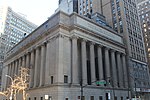Keens Steakhouse
1885 establishments in New York (state)America's Classics winnersRestaurants established in 1885Restaurants in ManhattanSteakhouses in New York City ... and 1 more
Use mdy dates from January 2013

Keens Steakhouse (formerly Keen’s English Chop House) is a steakhouse restaurant located at 72 West 36th Street (between Fifth Avenue and Sixth Avenue) in the Garment District in Manhattan, New York City. The restaurant houses more than 50,000 clay smoking pipes, making it one of the largest collections in the world. The establishment is also famous for their renowned mutton chops.
Excerpt from the Wikipedia article Keens Steakhouse (License: CC BY-SA 3.0, Authors, Images).Keens Steakhouse
West 36th Street, New York Manhattan
Geographical coordinates (GPS) Address Nearby Places Show on map
Geographical coordinates (GPS)
| Latitude | Longitude |
|---|---|
| N 40.7508 ° | E -73.98656 ° |
Address
West 36th Street 76
10018 New York, Manhattan
New York, United States
Open on Google Maps





